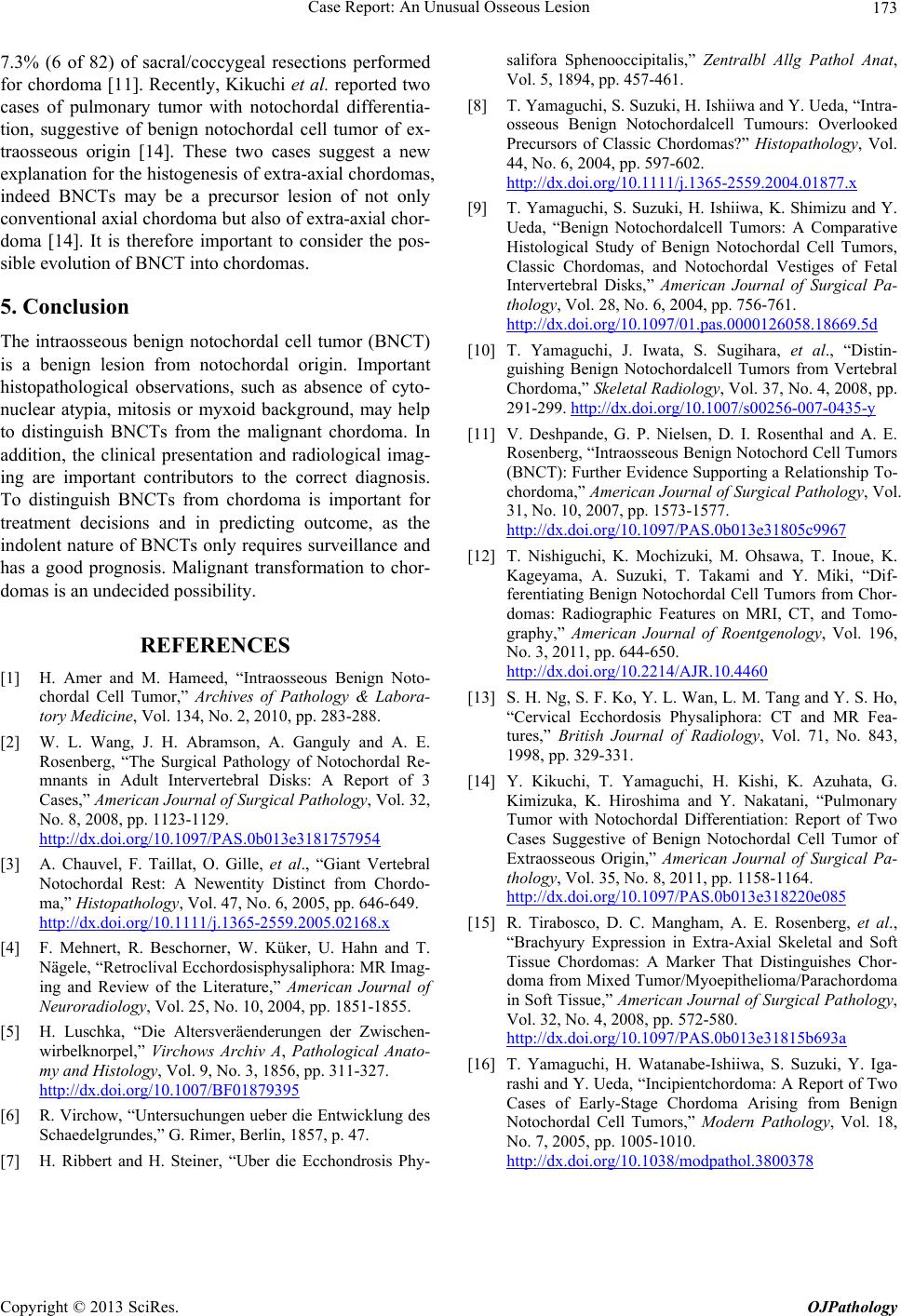
Case Report: An Unusual Osseous Lesion
Copyright © 2013 SciRes. OJPathology
173
7.3% (6 of 82) of sacral/coccygeal resections performed
for chordoma [11]. Recently, Kikuchi et al. reported two
cases of pulmonary tumor with notochordal differentia-
tion, suggestive of benign notochordal cell tumor of ex-
traosseous origin [14]. These two cases suggest a new
explanation for the histogenesis of extra-axial chordomas,
indeed BNCTs may be a precursor lesion of not only
convention al axial chordo ma but also of extra-axial ch or-
doma [14]. It is therefore important to consider the pos-
sible evolution of BNCT into chordomas.
5. Conclusion
The intraosseous benign notochordal cell tumor (BNCT)
is a benign lesion from notochordal origin. Important
histopathological observations, such as absence of cyto-
nuclear atypia, mitosis or myxoid background, may help
to distinguish BNCTs from the malignant chordoma. In
addition, the clinical presentation and radiological imag-
ing are important contributors to the correct diagnosis.
To distinguish BNCTs from chordoma is important for
treatment decisions and in predicting outcome, as the
indolent nature of BNCTs only requires surveillance and
has a good prognosis. Malignant transformation to chor-
domas is an undecided possibility.
REFERENCES
[1] H. Amer and M. Hameed, “Intraosseous Benign Noto-
chordal Cell Tumor,” Archives of Pathology & Labora-
tory Medicine, Vol. 134, No. 2, 2010, pp. 283-288.
[2] W. L. Wang, J. H. Abramson, A. Ganguly and A. E.
Rosenberg, “The Surgical Pathology of Notochordal Re-
mnants in Adult Intervertebral Disks: A Report of 3
Cases,” American Journal of Surgical Pathology, Vol. 32,
No. 8, 2008, pp. 1123-1129.
http://dx.doi.org/10.1097/PAS.0b013e3181757954
[3] A. Chauvel, F. Taillat, O. Gille, et al., “Giant Vertebral
Notochordal Rest: A Newentity Distinct from Chordo-
ma,” Histopathology, Vol. 47, No. 6, 2005, pp. 646-649.
http://dx.doi.org/10.1111/j.1365-2559.2005.02168.x
[4] F. Mehnert, R. Beschorner, W. Küker, U. Hahn and T.
Nägele, “Retroclival Ecchordosisphysaliphora: MR Imag-
ing and Review of the Literature,” American Journal of
Neuroradiology, Vol. 25, No. 10, 2004, pp. 1851-1855.
[5] H. Luschka, “Die Altersveräenderungen der Zwischen-
wirbelknorpel,” Virchows Archiv A, Pathological Anato-
my and Histology, Vol. 9, No. 3, 1856, pp. 311-327.
http://dx.doi.org/10.1007/BF01879395
[6] R. Virchow, “Untersuchungen ueber die Entwicklung des
Schaedelgrundes,” G. Rimer, Berlin, 1857, p. 47.
[7] H. Ribbert and H. Steiner, “Uber die Ecchondrosis Phy-
salifora Sphenooccipitalis,” Zentralbl Allg Pathol Anat,
Vol. 5, 1894, pp. 457-461.
[8] T. Yamaguchi, S. Suzuki, H. Ishiiwa and Y. Ueda, “Intra-
osseous Benign Notochordalcell Tumours: Overlooked
Precursors of Classic Chordomas?” Histopathology, Vol.
44, No. 6, 2004, pp. 597-602.
http://dx.doi.org/10.1111/j.1365-2559.2004.01877.x
[9] T. Yamaguchi, S. Suzuki, H. Ishiiwa, K. Shimizu and Y.
Ueda, “Benign Notochordalcell Tumors: A Comparative
Histological Study of Benign Notochordal Cell Tumors,
Classic Chordomas, and Notochordal Vestiges of Fetal
Intervertebral Disks,” American Journal of Surgical Pa-
thology, Vol. 28, No. 6, 2004, pp. 756-761.
http://dx.doi.org/10.1097/01.pas.0000126058.18669.5d
[10] T. Yamaguchi, J. Iwata, S. Sugihara, et al., “Distin-
guishing Benign Notochordalcell Tumors from Vertebral
Chordoma,” Skeletal Radiology, Vol. 37, No. 4, 2008, pp.
291-299. http://dx.doi.org/10.1007/s00256-007-0435-y
[11] V. Deshpande, G. P. Nielsen, D. I. Rosenthal and A. E.
Rosenberg, “Intraosseous Benign Notochord Cell Tumors
(BNCT): Further Evidence Supporting a Relationship To-
chordoma,” American Journal of Surgical Pathology, Vol.
31, No. 10, 2007, pp. 1573-1577.
http://dx.doi.org/10.1097/PAS.0b013e31805c9967
[12] T. Nishiguchi, K. Mochizuki, M. Ohsawa, T. Inoue, K.
Kageyama, A. Suzuki, T. Takami and Y. Miki, “Dif-
ferentiating Benign Notochordal Cell Tumors from Chor-
domas: Radiographic Features on MRI, CT, and Tomo-
graphy,” American Journal of Roentgenology, Vol. 196,
No. 3, 2011, pp. 644-650.
http://dx.doi.org/10.2214/AJR.10.4460
[13] S. H. Ng, S. F. Ko, Y. L. Wan, L. M. Tang and Y. S. Ho,
“Cervical Ecchordosis Physaliphora: CT and MR Fea-
tures,” British Journal of Radiology, Vol. 71, No. 843,
1998, pp. 329-331.
[14] Y. Kikuchi, T. Yamaguchi, H. Kishi, K. Azuhata, G.
Kimizuka, K. Hiroshima and Y. Nakatani, “Pulmonary
Tumor with Notochordal Differentiation: Report of Two
Cases Suggestive of Benign Notochordal Cell Tumor of
Extraosseous Origin,” American Journal of Surgical Pa-
thology, Vol. 35, No. 8, 2011, pp. 1158-1164.
http://dx.doi.org/10.1097/PAS.0b013e318220e085
[15] R. Tirabosco, D. C. Mangham, A. E. Rosenberg, et al.,
“Brachyury Expression in Extra-Axial Skeletal and Soft
Tissue Chordomas: A Marker That Distinguishes Chor-
doma from Mixed Tumor/Myoepithelioma/Parachordoma
in Soft Tissue,” American Journal of Surgical Pathology,
Vol. 32, No. 4, 2008, pp. 572-580.
http://dx.doi.org/10.1097/PAS.0b013e31815b693a
[16] T. Yamaguchi, H. Watanabe-Ishiiwa, S. Suzuki, Y. Iga-
rashi and Y. Ueda, “Incipientchordoma: A Report of Two
Cases of Early-Stage Chordoma Arising from Benign
Notochordal Cell Tumors,” Modern Pathology, Vol. 18,
No. 7, 2005, pp. 1005-1010.
http://dx.doi.org/10.1038/modpathol.3800378